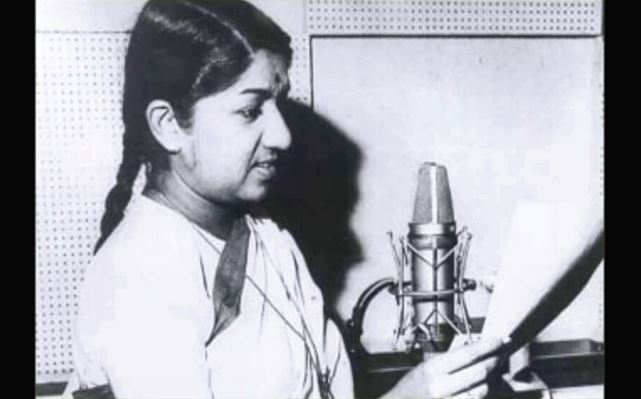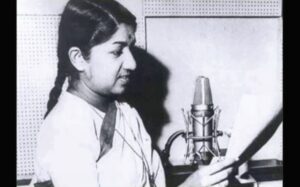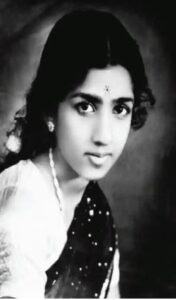How do you encapsulate in words the persona and work of a virtuoso who held an unchallenged sway in a calling where careers are fickle enough to be made or marred in no time? Especially if it is Lata Mangeshkar who virtually saw the evolution of Indian cinema to eventually become a dominant force and become a part of India’s musical consciousness spanning over seven incredible decades and swamping lives?
Reams and reams have been written about her but she never fails to expose newer vistas of her mind boggling talent that set generations aflame. Her songs with their majestic range shine like stars on the musical firmament and refuse to fade away. Each of her songs has carried the same whiff of fresh air ages after it emerged out of her god-gifted throat. It is a telling commentary about her unbelievable repertoire that her songs are the lips of an octogenarian grandma to a growing adolescent girl.
The signature mellifluosity, crystal clear and pristine voice flows serenely as radios, music players and music channels keep playing her songs day in day out. Since Lata stood before the mike at barely 12, much before India managed to wriggle out of the British clutches, it would be worthwhile to bisect her colossal singing career into one from 1945 to 1958 and from then onwards. The Lata in this period was vintage, chaste, refined with almost a girlish inflection to it.
It is surprising that while film-producer Shashdhar Mukherjee rejected her for her “too thin” voice was exactly why composers of that era precisely latched on to hers. Her debut in 1946 Paa lagoon kar jori (Aap Ki Seva Mein) is a case in point. It became her raison d’etre. In the pantheon of Hindi film music Vasant Desai rarely got his due deployed Lata in Chidiya bole choon choon maina bole hoon (Jeevan Yatra- 1946) and Piya aayega gori shudh na bisar (Subhadra- 1946)). It brought to fore her extraordinary ability to negotiate the classical strains that came out so resonatingly in her adolescent voice.
The man who first realised the 24-carat gold in her frail throat was Ghulam Haider. In 1948, he extracted that in Ab kaun sahara hai jab tera sahara (Ziddi) and Dil mera toda (Majboor). C Ramchandra took cue and got her vocal refrain Zulm tumhare seh na sake (Namoona-1949). Even as Haider and Anna Chitalkar vied to bring her to the recording studios, the next biggest thing happened with Barsaat (1948) as Shankar-Jaikishen the longest surviving composer duo took the nation on a lilting trip with Do din ke liye mehmaan yahan and Unse pyaar ho gaya (Badal-1951) and Lata literally toying with two contradictory notes.
While Barsaat put Lata’s career on a high trajectory, Anil Biswas and Shyamsunder were preparing her for bigger things. Tum hi kaho mera man kyon rahe udaas (Girls School-1949) was the beginning of a fruitful combine with Anil Biswas that turned out to be a veritable feast with gems like Tumhare bulane ko jee chahata hai and Zindagi ki roshani to kho gayi (Laadli-1949) and Beimaan tore nainwa (Sangdil-1951). Such was Biswas’ faith in Lata that he got Lata to sing as many as seven solos in Anokha Pyaar (1948) to set tone for Shankar-Jaikishen (SJ) with eight songs in Barsaat.
At this juncture, Lata who was struggling to come to grips with the rigours of life – barely in her twenties and trying to provide a protective umbrella to her equally musically inclined four siblings – had even mustered up courage to start teaching music to fellow students after which she was severely berated by her teachers. She never went back to school after that. That was just as well as she was stepping up to become a benchmark of perfection and purity unheard of in the annals of music. She more than made up for this lack of academic education by being a voracious reader. Her grasp of scriptures, art and wide spectrum of literature brought her the erudition that resonated from her articulation. She was a prima donna in the making.
What Biswas and SJ could not do with seven plus songs, composers like Khemchand Prakash and Shyamsunder did with just two songs. Remember the iconic Aayega aanewaala mystic that hit the pop charts from Mahal (1949) but it was Mushkil hai bahot mushkil that won critical acclaim. From the Punjabi Shyamsunder’s host of songs Bahare phir bhi aayengi (Lahore-1949) stood apart. A few composers like Pandit Gobindram (Maa Ka Pyaar- 1949), Vinod (Ek Thi Ladki-1949) and Bulo C Rani (Nazaare-1949) were just the props that ensured Lata’s feet were firmly planted in an industry where longevity was alien.
Even as C Ramchandra and Vasant Desai were emerging from their shadows, two more composers, Ghulam Mohammed (Shair-1949) and Husnlal Bhagatram (Saawan Bhadon-1949) had devolved upon themselves to give Lata’s voice a cutting edge. Both swore by Hindustani Sangeet. The journey with Ghulam Mohammed started with Too door hai ankhon se mere dil ko yeh gham (Shair-1949) and Unse hum kuch kehte kehte reh gaye (Dil Ki Basti-1949) continued till Pakeezah (1972). Husnlal Bhagatram, much acknowledged before Shankar-Jaikishan hit the scene, was the first to realise that the Rafi-Lata combo worked wonders but Lata endears on her own with O rooth janewale mera kasoor kya hai (Rakhi-1949) and Teri is do rangi duniya mein (Saawan Bhadon-1949).
One composer, somewhat under-rated is Hansraj Behl who got to sing one of the best ditties perhaps in the realms offilm music. Haaye jiya roye (Milan-1958) was the crowning glory that Behl composed after recording four solos in Zevraat (1950) and three in Khamosh Sipahi (1950).
Meanwhile, you couldn’t have ignored the doyen of classical composers Naushad who spun one classical gem after another starting with that intensely arresting Uthaaye jaa un ke sitam, Tod diya dil mera and Dar naa muhabbat kar le (Andaaz-1949). Capitalizing on Lata’s divine vocals he recorded seven solos in Dulari (1949) that had such surpassing melodies like Taqdeer jaga kar aayi hoon and Aye dil tujhe kasam hai.
For those wondering why Madan Mohan (MM) hasn’t figured in the scheme of things here, the simple reason is it actually calls for a separate chapter. Lata’s relationship with ‘bhaiyya’ Madan Mohan is well-documented — she was his favourite singer, and he probably her favourite composer. The duo aligned to create some of the most memorable hits in Hindi cinema history. His ghazals with Lata are sheer serenity. From classical to soft romantic and comic, he explored Lata’s entire range as only he could.
Madan Mohan produced two polished diamonds for Lata with Preetam meri duniya mein and Saanwari surat man bhaayi re piya (Adaa-1951) and following up two years later with Hamaare baad ab mehfil mein ye afsaane and Taare khile aayi raat (Baaghi-1953). Lata’s songs from Aankhen (1950), Aashiana and Nirmohi (1952) came as a devastating combination that had a different flavour and ethos of its own. The quality that this tandem brought from their early days continued until Madan Mohan passed away in 1975 at a relatively young age of 51. While the quality of music was moving slowly towards degeneration with cacophony beginning to set in, MM didn’t succumb to the wily, commercial ways of the industry. It was also an eloquent commentary on the emerging new generation who had little patience and choice for the vintage music of the yore.
(To be concluded in the next issue)


 Lata Mangeshkar made her singing debut in a studio at the age of 13
Lata Mangeshkar made her singing debut in a studio at the age of 13
